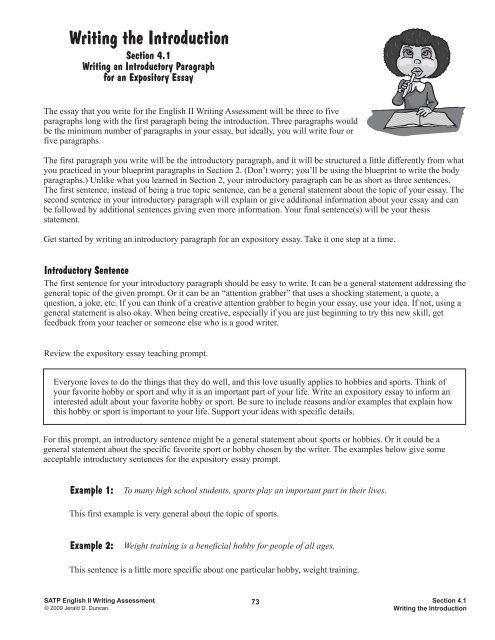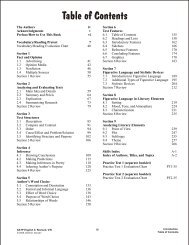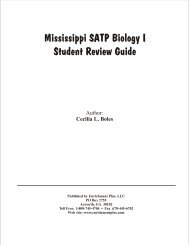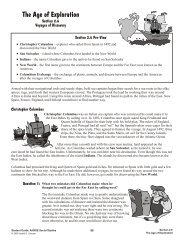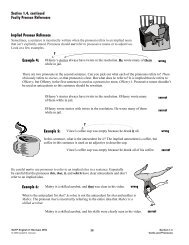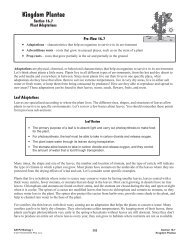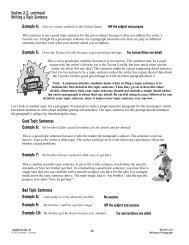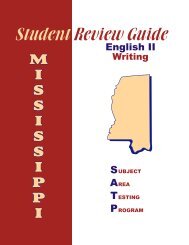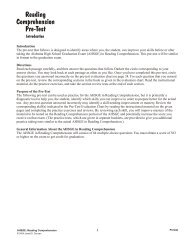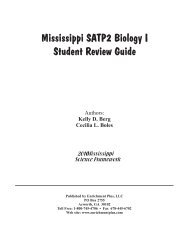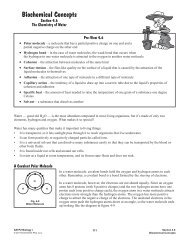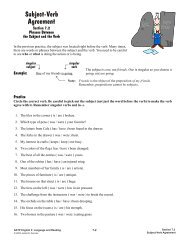MS Writing samples a - Enrichment Plus
MS Writing samples a - Enrichment Plus
MS Writing samples a - Enrichment Plus
- No tags were found...
You also want an ePaper? Increase the reach of your titles
YUMPU automatically turns print PDFs into web optimized ePapers that Google loves.
<strong>Writing</strong> the IntroductionSection 4.1<strong>Writing</strong> an Introductory Paragraphfor an Expository EssayThe essay that you write for the English II <strong>Writing</strong> Assessment will be three to fiveparagraphs long with the first paragraph being the introduction. Three paragraphs wouldbe the minimum number of paragraphs in your essay, but ideally, you will write four orfive paragraphs.The first paragraph you write will be the introductory paragraph, and it will be structured a little differently from whatyou practiced in your blueprint paragraphs in Section 2. (Don’t worry; you’ll be using the blueprint to write the bodyparagraphs.) Unlike what you learned in Section 2, your introductory paragraph can be as short as three sentences.The first sentence, instead of being a true topic sentence, can be a general statement about the topic of your essay. Thesecond sentence in your introductory paragraph will explain or give additional information about your essay and canbe followed by additional sentences giving even more information. Your final sentence(s) will be your thesisstatement.Get started by writing an introductory paragraph for an expository essay. Take it one step at a time.Introductory SentenceThe first sentence for your introductory paragraph should be easy to write. It can be a general statement addressing thegeneral topic of the given prompt. Or it can be an “attention grabber” that uses a shocking statement, a quote, aquestion, a joke, etc. If you can think of a creative attention grabber to begin your essay, use your idea. If not, using ageneral statement is also okay. When being creative, especially if you are just beginning to try this new skill, getfeedback from your teacher or someone else who is a good writer.Review the expository essay teaching prompt.Everyone loves to do the things that they do well, and this love usually applies to hobbies and sports. Think ofyour favorite hobby or sport and why it is an important part of your life. Write an expository essay to inform aninterested adult about your favorite hobby or sport. Be sure to include reasons and/or examples that explain howthis hobby or sport is important to your life. Support your ideas with specific details.For this prompt, an introductory sentence might be a general statement about sports or hobbies. Or it could be ageneral statement about the specific favorite sport or hobby chosen by the writer. The examples below give someacceptable introductory sentences for the expository essay prompt.Example 1:To many high school students, sports play an important part in their lives.This first example is very general about the topic of sports.Example 2:Weight training is a beneficial hobby for people of all ages.This sentence is a little more specific about one particular hobby, weight training.SATP English II <strong>Writing</strong> Assessment© 2009 Jerald D. Duncan73Section 4.1<strong>Writing</strong> the Introduction
Section 5.2, continued<strong>Writing</strong> the Body Paragraphsfor a Position PaperIf you choose to write a non-formulaic thesis statement that is more general, it may be more difficult for you to stayfocused in your essay. Be careful to avoid the following pitfalls when writing body paragraphs:Important “Don’ts” in Body ParagraphsDon’t use circular reasoning (or “talk in circles”).Don’t repeat the same idea over and over.Don’t simply list reasons without giving examples.Don’t be vague. Be specific.You’ve already seen some of these “don’ts” in Section 5.1. Do you remember the warning to use specific examplesand details and to avoid being vague or general? The same applies to position papers.Now consider an introductory paragraph with a very general thesis sentence. In the following examples, Example 2and Example 3, notice how easy it is for the writer to stumble over the pitfalls given above.Example 2:Introductory Paragraph:Imagine being in a dead-end job that you hate. Now imagine being forced to do the samework that you hate but not even getting paid for it. The situation is unthinkable, isn’t it? No, it isactually a reality for high school students who are required to do community service. I disagreewith this policy to force students to perform community service because it accomplishes nothinggood for the students.Body Paragraph:Forcing students to do community service is a bad idea. It doesn’t help the students to learnanything new. If students don’t learn anything new, then it doesn’t do them any good. Studentsshould always learn new things or else they don’t learn anything. Instead of doing somethingthat doesn’t teach them anything, they should do something that teaches them something new. Ifstudents are going to succeed in life, they need to learn new things in school.Circular Reasoning:Circular reasoning is saying something like the following: “I like John because he is my favorite person.”Circular reasoning doesn’t give a reason at all. Can you pick out circular reasoning in Example 2? “Studentsshould always learn new things or else they don’t learn anything” and “Instead of doing something thatdoesn’t teach them anything, they should do something that teaches them something new” are examples ofcircular reasoning.Repetition:The body paragraph given in Example 2 is a good example of repeating the same idea over and over again. Thewriter goes around and around saying the same thing: community service doesn’t teach students anything new.The writer doesn’t give any specific examples or details.Be careful not to write this way. See Example 4 for how these ideas could be used, explained, and supported ina paragraph without going around in circles and without repeating the same idea over and over again.SATP English II <strong>Writing</strong> Assessment© 2009 Jerald D. Duncan99Section 5.2<strong>Writing</strong> the Body and the Conclusion
<strong>Writing</strong> the Bodyand the ConclusionSection 5.4<strong>Writing</strong> the Conclusion ParagraphRegardless of which type of essay you are writing, the conclusion paragraph serves the samepurpose in each — it finishes the essay.The conclusion will be the final paragraph for your essay. The conclusion ties together what you have alreadysaid in your essay. It should give the reader a sense of completion instead of your essay ending abruptly. Itshould also emphasize the purpose of your essay so that the reader is not left guessing. The following is a general listof things you should and should not include in your conclusion. You do not need to include all the “do’s” in yourconclusion, but you should definitely avoid the “do nots.”DODO summarize your essay by restating your thesis and main points in a different way.DO show how the points in your expository essay fit together.DO emphasize your position in your position paper.DO restate your interpretation and main point(s) in your response to literature.DO give your opinions or comments about what you have just written.DO explain why the points in your essay are significant.DO make recommendations based on the main points in your essay.DO NOTDO NOT repeat your thesis or introductory paragraph word for word.DO NOT introduce new ideas that have not been supported by details in your essay.DO NOT write just one sentence or end with a general (vague) statement.DO NOT end your essay by saying “The End.”Look at the example essays that have been written to this point. The following examples give good and badconclusions. First, look at the expository essay.Example 1:Introductory Paragraph:To many high school students, sports play an important part in their lives. For some, sportsoffer an opportunity to be a part of a team and to be accepted by their peers. To others, sportsteach sportsmanship, discipline, and cooperation. For me, playing baseball on our high schoolteam has been an important part of my life. It helps me to keep in shape, it has taught me theimportance of practice and hard work, and it makes me popular with the girls.SATP English II <strong>Writing</strong> Assessment© 2009 Jerald D. Duncan109Section 5.4<strong>Writing</strong> the Body and the Conclusion
Introducing ProofreadingSection 6.1Using the Writer’s ChecklistCongratulations! You should have now written the first drafts of your essays. Youare not finished yet. The next step is proofreading your essays to find and correct anymistakes and to make your essays even better.No matter how good a writer you are, you can always improve an essay by rereading, revising, and rewriting it. Themore you write and the more you practice editing, the better you will be able to write your first draft. However, a firstdraft should never be your final draft. Not even great writers accept their first draft without revising it.In the remaining sections of this book, you will review the skills that you need in order to proofread and correct youressays. Look at the checklist below. The checklist contains questions to help you write a passing essay.Writer’s ChecklistContent/OrganizationDid I write about the topic selected?Did I write a thesis statement that clearly focuses on the topic?Did I use multiple paragraphs to create an introduction, body, and conclusion?Did I include relevant supporting details to develop my topic or position?Did I use purposeful transition within and between paragraphs?Did I organize my response in a manner that is appropriate for the topic?Did I address the appropriate audience and purpose in my response?Sentence StructureDid I vary the structure and length of my sentences in a meaningful way?Did I use sentence variety to create an effective flow of ideas?LanguageDid I consistently use language that is precise, powerful, and appropriate?Did I use language to enhance the development and clarity of my ideas?<strong>Writing</strong> ConventionsDid I correct any errors in spelling, usage, punctuation, and capitalization?Did I print or write clearly?So far in this book, you have concentrated mostly on content and organization of your essays. The items checked offthe list represent the things that you should have done in the rough draft of your own essays. In the rest of this book,you’ll review skills so that you can check off the rest of them. As you can see, six of the boxes are checked. You haveseven more to go. You still have some work to do!SATP English II <strong>Writing</strong> Assessment© 2009 Jerald D. Duncan117Section 6.1Introducing Proofreading


